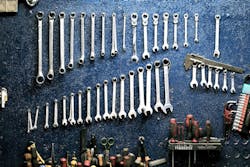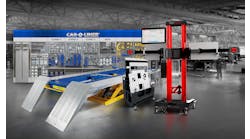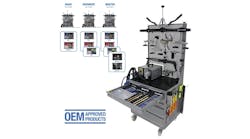A blueprint is a complete plan; it’s what everyone working on a project references. A blueprint is how a team gets a project from beginning to end. That’s why Michael Hoeneise, training manager for Car-O-Liner, is making a push for all shops to implement a complete blueprint for each and every repair.
Blueprinting vs. Teardown
Some call it a blueprint, others a teardown––the importance of the process doesn’t change, but the terms used from shop to shop might. Hoeneise prefers “blueprint.”
“It’s more comprehensive,” Hoeneise says of the term blueprint. “We need to consider everything that needs to be done to get the car out.”
Teardown, on the other hand, sounds like it’s only referring to physical damage, Hoeneise says. With vehicles becoming more advanced every day, it’s not enough to only address what can be seen. Shops need to look at how a collision impacts every system in the vehicle.
Blueprint, teardown—whatever your shop calls it, Hoeneise says the most important thing is to make sure there’s a system in place that will catch all repair issues up front rather than dealing with problems throughout the repair, which can cause delays and result in increased cycle time and lower CSI scores. Hoeneise, a former technician, estimates that less than 10 percent of collision repair shops do an effective blueprint on every repair.
A Necessary Process
When looking at a shop with an effective blueprint process versus one that doesn’t, the shop that doesn’t is going to look like it’s flying through the process, which is very appealing to techs, Hoeneise says. However, taking the time in the beginning saves time in the long run, and it also cuts back on having to go back on what has already been promised to customers.
“With blueprinting, it’s finding all the problems at once versus one popping up every three days,” Hoeneise says.
An incomplete blueprint can result in a range of problems—from minor delays to finding additional parts that are backordered to having to total a car after the fact.
Tips for Implementation
Hoeneise says the worst thing for a shop owner to do would be to read this article and walk into his or her shop the next day and say, “We’re doing this now.”
Before implementing any new process, Hoeneise says shop owners need to do the necessary research to ensure that he or she knows what exactly is required to execute it successfully. Hoeniese says before starting, shop owners need to get the necessary blueprint training.
Hoeneise says that many paint companies offer this and that I-CAR’s blueprinting class is great. He adds that there are a number of good books on the subject and that it never hurts to reach out to other shop owners that have successfully implemented it.
“You may have to go out of state to avoid competition,” Hoeneise says. “But there are a lot of shop owners that are happy to give a tour of their facility and demonstrate their processes.”
After researching but before implementation, Hoeneise says it’s important to get employee buy-in.
“Yes, you own the shop, but it’s easier if you have people’s cooperation instead of compliance,” Hoeneise stresses.
Call a meeting and explain why you’ve decided to do this. At this time, staff will have time to express concerns and as the owner, you can address them.
“The sooner you get buy-in, the sooner you can implement,” Hoeneise says.




